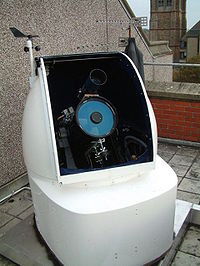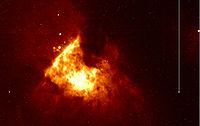
Project Galileo
Encyclopedia
Project Galileo is an educational astronomy project, based at Clifton College
in Bristol
, in the United Kingdom
.

being donated to a Bristol
school, with the overall aim of making the system available for other schools in the area to use. The system became operational in July 2005, and is expected to have full on-line capability by the autumn of 2008.
& Design & Technology courses at post-16 level, to inspire teenagers to "learn the art as well as science of research and research teams, how scientific research is practiced, how physical ideas become mainstream, how collaboration between scientific disciplines fosters greater understanding, and to encourage links and collaboration between schools of different age-ranges and traditions in the city of Bristol." (Project FAQ)
The project focuses on the issues surrounding the maintenance and successful operation of a remote-controlled observatory
. It is built around a remote-controlled telescope with a 1.3 metre dome and CCD
camera located in Bristol, which enables imaging and searches of comets, asteroids, supernovae, deep-sky and planetary objects.
Other institutions using similar code are the DRACO project at Durham University and R.O.Y. (the Robotic Observatory at York), based at York University
. Project Galileo uses code developed by Dr John Lucey at Durham University
, and ROY is in the process of migrating from Windows-based software to code used by Project Galileo. All the code being developed is the work of volunteer efforts - if you wish to contribute, please visit the external links section below for more details.
Here is a simplified diagram of how the system works:
In reality, the backend database and control software consist of several systems, including an image processing cluster which is responsible for creating the final processed versions of the raw images that are taken by the telescope.
You can also view a larger selection of images taken with the observatory here & here.
Clifton College
Clifton College is a co-educational independent school in Clifton, Bristol, England, founded in 1862. In its early years it was notable for emphasising science in the curriculum, and for being less concerned with social elitism, e.g. by admitting day-boys on equal terms and providing a dedicated...
in Bristol
Bristol
Bristol is a city, unitary authority area and ceremonial county in South West England, with an estimated population of 433,100 for the unitary authority in 2009, and a surrounding Larger Urban Zone with an estimated 1,070,000 residents in 2007...
, in the United Kingdom
United Kingdom
The United Kingdom of Great Britain and Northern IrelandIn the United Kingdom and Dependencies, other languages have been officially recognised as legitimate autochthonous languages under the European Charter for Regional or Minority Languages...
.

History
Project Galileo started in December 2000, as a result of a telescopeTelescope
A telescope is an instrument that aids in the observation of remote objects by collecting electromagnetic radiation . The first known practical telescopes were invented in the Netherlands at the beginning of the 1600s , using glass lenses...
being donated to a Bristol
Bristol
Bristol is a city, unitary authority area and ceremonial county in South West England, with an estimated population of 433,100 for the unitary authority in 2009, and a surrounding Larger Urban Zone with an estimated 1,070,000 residents in 2007...
school, with the overall aim of making the system available for other schools in the area to use. The system became operational in July 2005, and is expected to have full on-line capability by the autumn of 2008.
Aims
Project Galileo aims to provide a curriculum resource for Science and Technology at Key Stages 3 & 4 and AS/A2 levels, including ICTICT (education)
Information and communication technologies in education deal with the use of information and communication technologies within educational technology.-Purpose:...
& Design & Technology courses at post-16 level, to inspire teenagers to "learn the art as well as science of research and research teams, how scientific research is practiced, how physical ideas become mainstream, how collaboration between scientific disciplines fosters greater understanding, and to encourage links and collaboration between schools of different age-ranges and traditions in the city of Bristol." (Project FAQ)
The project focuses on the issues surrounding the maintenance and successful operation of a remote-controlled observatory
Observatory
An observatory is a location used for observing terrestrial or celestial events. Astronomy, climatology/meteorology, geology, oceanography and volcanology are examples of disciplines for which observatories have been constructed...
. It is built around a remote-controlled telescope with a 1.3 metre dome and CCD
Charge-coupled device
A charge-coupled device is a device for the movement of electrical charge, usually from within the device to an area where the charge can be manipulated, for example conversion into a digital value. This is achieved by "shifting" the signals between stages within the device one at a time...
camera located in Bristol, which enables imaging and searches of comets, asteroids, supernovae, deep-sky and planetary objects.
How it works
Schools will be able to register via the main Project Galileo website (see #External links below), and then login to the telescope to order images, much in the same way as is done with other online school observatories. One important feature of the software being developed for the project is that it comes under the GPL, so other schools or institutions who want to develop similar systems will be able to modify the code rather than having to spend vital educational budgets for proprietary software. The code being used for the project can be found via the #External links.Other institutions using similar code are the DRACO project at Durham University and R.O.Y. (the Robotic Observatory at York), based at York University
University of York
The University of York , is an academic institution located in the city of York, England. Established in 1963, the campus university has expanded to more than thirty departments and centres, covering a wide range of subjects...
. Project Galileo uses code developed by Dr John Lucey at Durham University
Durham University
The University of Durham, commonly known as Durham University, is a university in Durham, England. It was founded by Act of Parliament in 1832 and granted a Royal Charter in 1837...
, and ROY is in the process of migrating from Windows-based software to code used by Project Galileo. All the code being developed is the work of volunteer efforts - if you wish to contribute, please visit the external links section below for more details.
Here is a simplified diagram of how the system works:
 |
In reality, the backend database and control software consist of several systems, including an image processing cluster which is responsible for creating the final processed versions of the raw images that are taken by the telescope.
Results so far
 |  |
| M13 Globular Cluster, July 2005 | M27 Planetary Nebula,July 2005 |
 |  |
| M42, Orion Nebula, December 2005 | Saturn, raw rgb images, December 2005 |
You can also view a larger selection of images taken with the observatory here & here.

